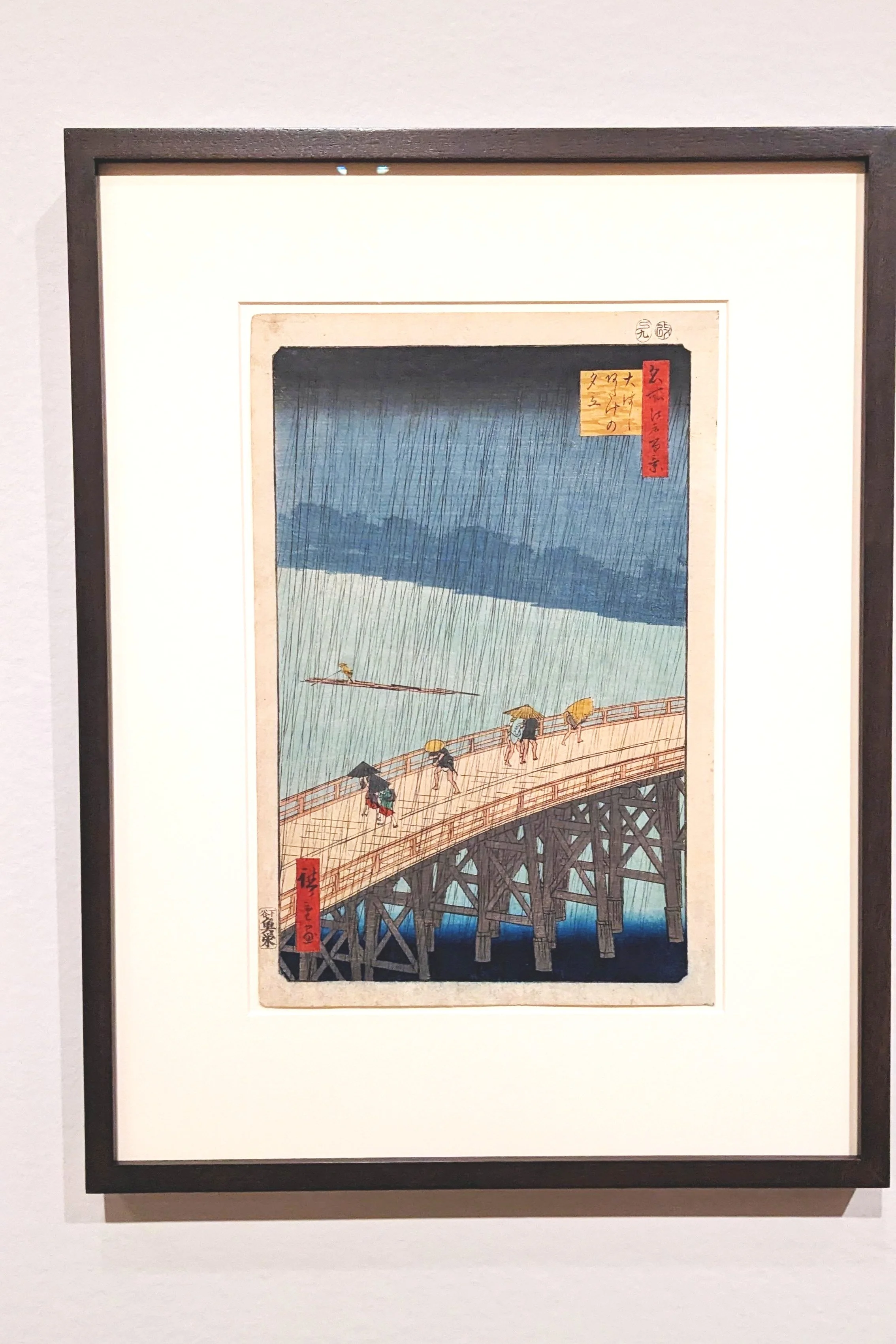Japanese Prints in Transition
Katsushika Hokusai's The Great Wave off Kanagawa, an iconic Japanese woodblock print from the Edo period, featuring a dramatic wave towering over boats with Mount Fuji in the background.
Perched on a hill overlooking the Golden Gate Bridge, the Legion of Honor is a place where history, art, and beautiful views come together. Located in Lincoln Park in the northwest part of San Francisco, the museum houses European paintings and sculpture, as well as ancient and contemporary art. The architecture alone is worth the visit which I believe is in the French neoclassical style. There’s even a trail next to the museum which is one of the best trails I’ve been on called Lands End Trail. However, the reason I went to the Legion of Honor wasn’t because of its views, trails, or architecture but for the new exhibit featuring Japanese woodblock printing.
An aerial view of the Legion of Honor in San Francisco, beautifully surrounded by green vegetation and the Golden Gate Bridge in the background. The museum's neoclassical architecture and surrounding Lincoln Park create a serene scene.
Titled Japanese Prints in Transition: From the Floating World to the Modern World, the exhibit traces the evolution of Japanese woodblock printing from its origins in the Edo period to its transformation during the Meiji era. I’ve always admired the elegance of ukiyo-e prints ever since I first studied them in my History of Graphic Design class at Fresno State. The technical mastery involved in creating these prints is nothing short of amazing. The delicate carving of the wooden blocks, the careful layering of pigments, and the precision of the printing process are incredible. These skills, passed down through generations of craftsmen, are as much a part of the story as the final artworks themselves.
The grand entrance of the Legion of Honor in San Francisco, showcasing its neoclassical columns and the inscription "Honneur et Patrie" above the facade.
Visitors admiring artifacts at the Japanese Prints in Transition: From the Floating World to the Modern World exhibit, set against a backdrop of cherry blossom-themed artwork. Photo Gary Sexton. San Francisco, 2024
The exhibit showcased works by artists like Hokusai and Hiroshige, whose landscapes and depictions of everyday life during the Edo period capture the beauty of “the floating world.” During this period, Japan opened its borders to the West, and the art of woodblock printing evolved to show these influences. The colors became richer, the subjects more diverse, and the scenes began to include elements of modern life like railways, steamships, and Western fashion.
One of the most iconic examples of ukiyo-e prints I saw at the exhibition was Hokusai’s The Great Wave off Kanagawa, a masterpiece that has become a symbol of Japanese art. Its bold composition, with the towering wave curling over tiny boats and the distant silhouette of Mount Fuji, embodies the elegance of ukiyo-e. It has become so ubiquitous in popular culture that it was even made into a Lego set, which I bought last year and have yet to put together to hang on my wall.
Hokusai’s masterpiece meets modern creativity—The Great Wave Lego set, ready to bring art to life, one brick at a time.
A framed woodblock print by Utagawa Hiroshige depicting travelers braving the rain on a wooden bridge, set against a serene, moody background.
A collection of framed woodblock prints by Hokusai, including the iconic The Great Wave off Kanagawa and other striking depictions of Mount Fuji, displayed at the Japanese prints exhibit.
I thought it was really cool how the exhibit showed the collaborative nature of how ukiyo-e were made. It’s easy to give credit to works only to the famous artists whose names we recognize today, but the prints were a team effort. The designer sketched the image, the carver cut the wooden blocks, and the printer meticulously applied the colors. It’s amazing to think about how much teamwork, coordination, and skill went into creating each piece.
If you want to get a better idea of how this process was like, I recommend checking out Miss Hokusai, an animated film about Hokusai’s daughter, O-Ei, who was a pretty good artist in her own right. The movie gives you a peek at the behind-the-scenes world of woodblock printing and the people who made it happen—it’s a great way to get a feel for the craftsmanship behind these prints.
The Legion of Honor’s Japanese woodblock exhibit is a must-see for anyone who loves art, design, history, or a good story of teamwork and craftsmanship. It’s a perfect mix of beauty, skill, and cultural evolution—all set against the backdrop of one of San Francisco’s most iconic locations.
The exhibition runs from April 6 – August 18, 2024.
Blu-ray cover of Miss Hokusai, an animated film directed by Keiichi Hara, showcasing the story of Hokusai’s daughter, O-Ei, and her contributions to ukiyo-e art.








